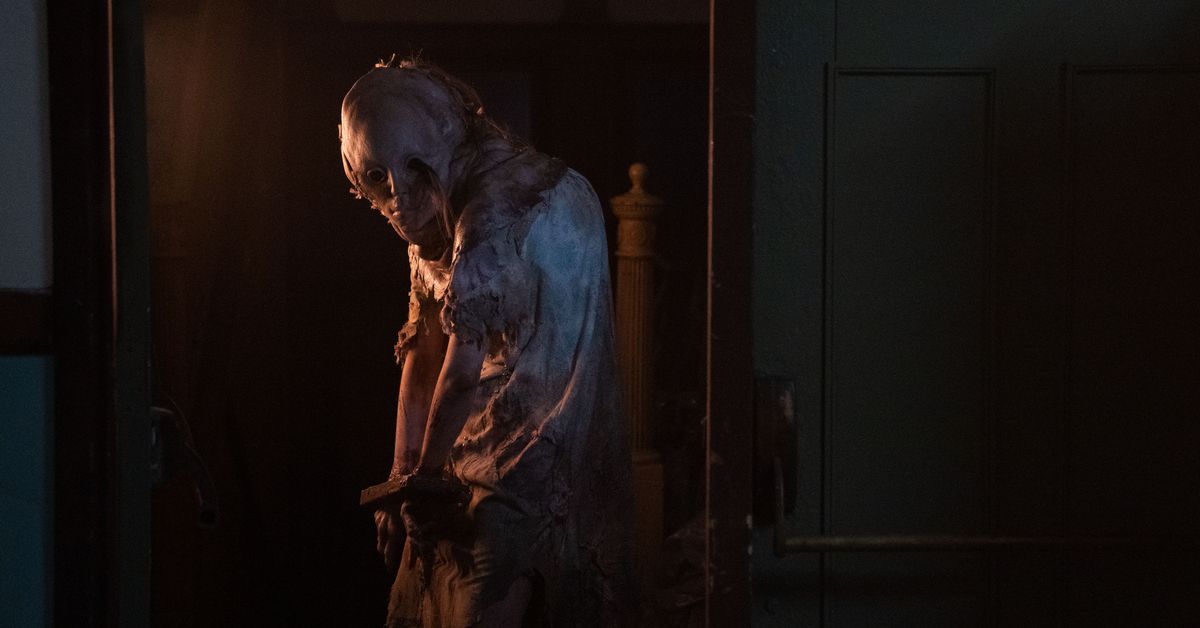
For years, Capcom’s Resident Evil franchise has been split in half. There’s the game and animated film series built closely around Shinji Mikami’s 1996 survival horror game. Then there’s the live-action series, a half-dozen barely related blockbusters starring Milla Jovovich. But the newly released Resident Evil: Welcome to Raccoon City aims to change that. It’s a jump-scare-filled live-action adaptation of the earliest Resident Evil games, and it plays out like a 107-minute fan film — which isn’t entirely a bad thing.
The following includes mild narrative and thematic spoilers.
Welcome to Raccoon City, written and directed by Johannes Roberts, merges the plots and characters of Resident Evil and Resident Evil 2. In the year 1998, the grim post-industrial town of Raccoon City has just lost its biggest employer, the Umbrella Corporation. To make things worse, college student Claire Redfield (Kaya Scodelario) believes Umbrella has polluted the town’s water with a mysterious and dangerous substance.
Claire’s elite police operative brother, Chris Redfield (Robbie Amell), initially doesn’t believe her. Then Chris, his trigger-happy partner Jill Valentine (Hannah John-Kamen), and hunky blond heartthrob Albert Wesker (Tom Hopper) are called to investigate a killing in a deserted mansion. Raccoon City’s population turns into flesh-eating zombies. Claire must team up with rookie cop Leon S. Kennedy (Avan Jogia) to escape. Along the way, she starts to unravel another mystery that’s bothered her for years: a grotesque creature that tried to befriend her as a child.
Roberts, who previously directed aquatic horror movie 47 Meters Down, has described his project as a “pure” adaptation compared to previous films. And Welcome to Raccoon City seems built to be dissected by fans. Its intertextual references will probably fill countless online Easter egg guides. I’m not a big enough Resident Evil completionist to fill those guides, but I got the palpable sense of watching something where the creators were showing their homework to gain viewers’ trust.
There’s a specific joy in watching scenes you love from other media get played out by real people in a movie, and Roberts has a good sense of what makes individual moments of translation satisfying. The filmmakers compose shots to evoke elements from the games even when the narrative context is different. They aren’t beholden to casting actors who look exactly like their in-game counterparts, but they hold onto details like Claire Redfield’s iconic red jacket. The script buys wholeheartedly into Resident Evil’s weird narrative quirks, like Raccoon City’s implausibly ornate police station, rather than trying to rationalize them or lampshade them with a joke.
The tradeoff is that Welcome to Raccoon City feels almost surreal through any other lens. If you’re not on board with Resident Evil’s mythos, you may find yourself wondering things like: “Why does a pharmaceutical corporation have a quasi-military strike force capable of containing an entire small town?” or “How does this small town have enough orphans to fill a school-sized building?” or “Did the corporation really need to dig a secret tunnel network that is accessed with playing-card-themed keys, and how long are those tunnels, anyway?” If you asked me to draw a map of Raccoon City after watching this movie, it would look like a tesseract.
The feeling is compounded by the cast’s incredibly calm performances. Welcome to Raccoon City is a gory mess of dismemberment, accidental self-immolation, and ravening zombie mobs, and its survivors seem moderately irritated by these developments at best. Leon Kennedy, in particular, is played less like a fresh-faced cop out of his depth and more like a character from Jim Jarmusch’s deadpan satire The Dead Don’t Die or possibly an exasperated mailroom intern perpetually on the verge of stapling his own hands.
The issue isn’t that Welcome to Raccoon City is unrealistic or that I couldn’t pore over a Resident Evil wiki to answer the questions above, but that the oddities never pay off. Things like Leon’s casual ineptitude could be effective comedy, but other characters stay similarly nonchalant through events the narrative suggests should devastate them. And instead of leaning into video game set pieces that look absolutely bizarre in a live-action film, the film glosses over them in favor of more generic action scenes.
Despite this, Welcome to Raccoon City goes a long way by gleefully embracing primal creepiness. Its first 20 minutes push every available button to freak viewers out: eerie dolls, rasping voices from the shadows, scrawled warnings from strange creatures, cheerful children’s drawings with ominous undertones, and much more. It evolves quickly into an action-horror narrative after this, but it still draws on the strength of Resident Evil’s spooky aesthetic.
Welcome to Raccoon City gets a lot of moment-to-moment elements right. It’s a film that’s straight-faced without being pretentious, full of over-the-top genre tropes without falling into grating, campy self-awareness. But it’s sunk so deep in a decades-old fictional world that it can’t look beyond its boundaries. The film delivers a checklist to remind viewers why they like Resident Evil — but it sometimes seems to forget what’s actually on it.
Resident Evil: Welcome to Raccoon City will premiere in theaters November 24th.
Article From & Read More ( Resident Evil: Welcome to Raccoon City review: a feature-length fan film - The Verge )https://ift.tt/3DL4kuT
Film
Bagikan Berita Ini














0 Response to "Resident Evil: Welcome to Raccoon City review: a feature-length fan film - The Verge"
Post a Comment